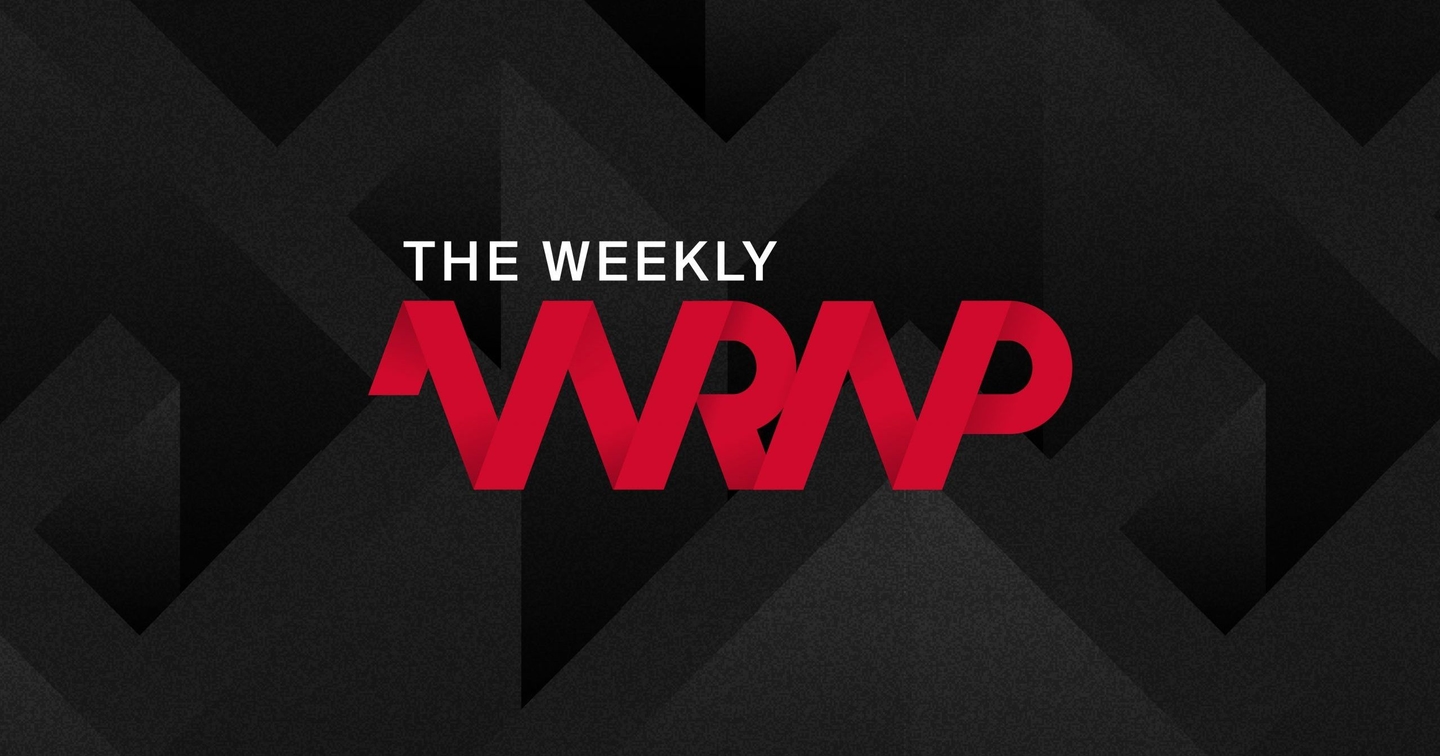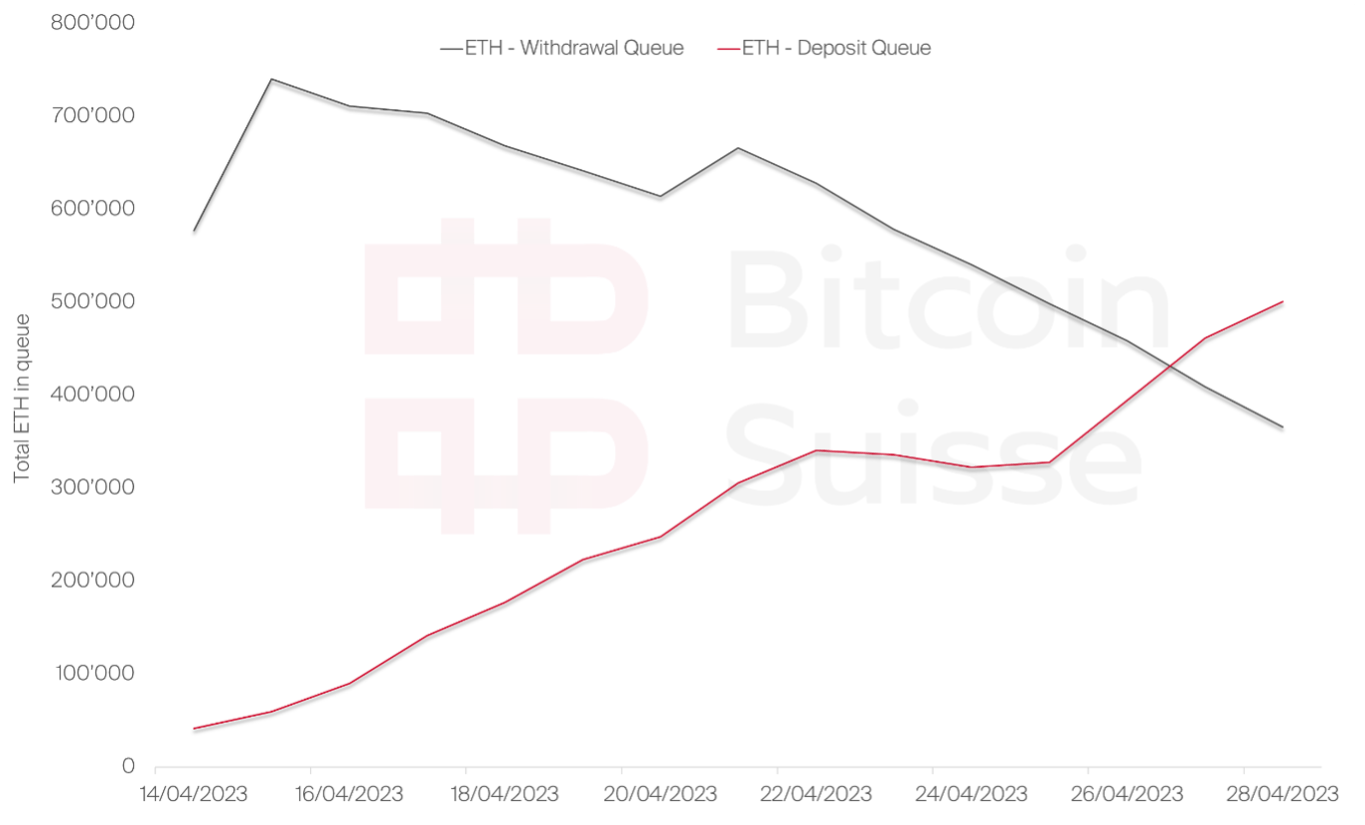
ETH staking turns bullish, Argentina’s bailout and the U.S. debt crises promoting crypto

1. Ethereum: the floodgates are open
The Facts:
- As of the 26th of April, the entry queue for staking ETH is longer than the queue for withdrawing ETH from staking.
- Current data from Metrika shows that the entry queue has 15’672 ETH, whereas only 11’409 ETH are waiting for withdrawal.
- In line with our Decrypt’s “Shanghai upgrade and what it means for investors” predictions, the sell pressure so far has been limited for ETH, and it took less than three weeks for ETH staking inflows to outpace outflows.
Our Take:
- As predicted, the so called Shapella upgrade, enabling staking withdrawals, turned out to be a very bullish catalyst for the Ethereum network and the price of ETH.
- Within a mere 16 days, the outflows of ETH from staking have been digested, and ETH holders waiting in line to get their ETH staked more than compensate for the remaining unstaking demand.
- As a result, it can be expected that the pace at which ETH gets staked, and therefore taken out of the freely available floating supply, will grow at an increasing pace.
- Consequently, the combination of deflationary monetary traits of ETH, as well as less supply being available for trading, will likely be the underlying drivers that enable a positive price development for ETH going forward.
- Nevertheless, as the deposit queue for ETH staking is growing, so are the opportunity costs of having one’s ETH sitting idle, before starting to accrue staking rewards.
- A counter force to the ETH price rising substantially in the interim, due to deflation and less floating supply on the market, is liquid staking however, allowing for “paper ETH” to be traded, which will dampen the bullish price progression somewhat.
- Nevertheless, we do not project this headwind to be significant, and potentially to even fuel the ETH price dynamics, because liquid staking makes the staking of native ETH more attractive and economic.
Plotting the ETH withdrawal end deposit queue

2. Argentina’s crisis and the IMF’s fear of crypto
The Facts:
- Argentina is set to receive a 45 billion U.S. Dollar bailout by the International Monetary Fund (IMF), only if Argentina will adopt an anti-crypto stance.
- Argentina’s economic crisis is unfolding after being struck by inflation rates exceeding 100%, while its U.S. denominated debt amounts to around 45% of its GDP.
- The IMF claims that crypto has possible adverse impacts on financial stability and Argentina’s ability for economic recovery – though admitting itself that these acclaimed crypto related risk “have not materialized” in other countries.
Our Take:
- Overall, it is clear what the actual intent of the IMF’s bailout being dependent on an anti-crypto stance is, given that crypto grew increasingly in popularity in Argentina, ranking 13th in terms of crypto adoption for the year 2022.
- Crypto adoption and its popularity are growing as a consequence of Argentina’s economic and financial troubles, rather than crypto adoption being the root cause of its economic misery – which adds further evidence that the concern about crypto is unrelated to the actual problem.
- Given inflation rates of more than 100%, people’s purchasing power gets halved in less than a year, causing people to look for an actual inflation hedge and a way out of their “fiat misery”, leading them to increasingly adopt crypto.
- Ironically, the current bailout is just another attempt of the IMF attempting to force countries to stay loyal to the U.S. Dollar dominance, while Argentina itself already began settling its foreign trade with China in Yuan, instead of U.S. Dollars as in the past.
- Similarly, the BRICS nations are working on a new currency in an attempt to mitigate U.S. Dollar dependency.
- Simultaneously, U.S. Dollar denominated stablecoins are being fought and attacked in the U.S., though they would be one of the few decentralized, crypto native vehicles that would in fact strengthen and sustain the position and global competitiveness of the U.S. Dollar overall.
- However, crypto adoption in “dollar dependent countries” as well as decentralized stablecoins are disintermediating the entities in control of the U.S. Dollar, which is the bigger stake, compared to just sustaining the dominant currency itself.
- Generally, the current bailout is a clear indication of the ongoing power play, attempting to sustain the U.S. Dollar dominance and the direct control over the Dollar.
- However, the trend is continuing to move in the opposite direction, despite pressure and patronization attempts: de-dollarization is ongoing, and its competitiveness is fading, partially because of attempts to sustain it with too much pressure and preventing natural adoption and innovation to occur.
- In total it is a very bullish indication, as the IMF focusing on preventing a spread of crypto is a solid attestation that it is a worthy competitor that has the potential to aid the de-dollarization and disintermediation in the long-run, while moving closer towards truly decentralized financial systems.
102.5% annual inflation or 1.74% annual inflation?
Annual inflation rate of Argentina versus the current “inflation rate” of BTC, which will be cut in half during the 2024 halving.
3. First Republic Bank’s troubles and debt ceiling crisis in the U.S
The Facts:
- The banking crisis continues, with First Republic Bank (FRB) shaking after seeing more than $100 billion of its deposits withdrawn since the beginning of the year, causing its share price to plummet by more than 95% within the same period.
- On another front, an agreement on the currently non-binding exceedance of the U.S. debt ceiling has still not been made.
- In other parts of the world, the Reserve Bank of Zimbabwe is about to introduce a gold-backed digital currency as legal tender, in an effort to stabilize its local currency.
Our Take:
- With the First Republic Bank it is yet another bank that is starting to shake under the currently stringent financial conditions, and substantial deposit withdrawals.
- With FRB, we can see the latest institution falter under increased interest rates, amidst tight access to liquidity, which is also reflected in the ongoing debt ceiling crises.
- With the debt ceiling being raised three times under the Trump administration, and eight times under the Obama administration, the current solution of making the debt ceiling “non-binding” since being hit on January 19th this year, has been to take “extraordinary measures” – the global debt crises reached an unseen precedent.
- Historically, the solution to hitting the set debt limit has always been to increase the debt ceiling, whereas the current “extraordinary measures” of not abiding by the set limit sets a new precedent.
- Overall, the consequences of “transitory inflation” and tight financial conditions are still unfolding in the U.S., while on the contrary, the crypto asset class appears to recover and decouple.
- Interestingly enough, it is Zimbabwe issuing a physically backed digital currency, after its 2008 period of hyperinflation saw it printing 100 trillion Zimbabwean dollar notes.
- Going forward the stabilization and thriving of the crypto industry amidst the first financial crisis since its creation is a strong attestation to the adoption trend of crypto.
- Furthermore, a country issuing a physically backed digital currency, therefore being similarly scarce and limited in inflation such as BTC or ETH, is a sharp contrast to how the banking crises is being partially fought in the United States, which is to mainly blame it on crypto associated risks.
- Going forward, it is likely that the trend of adopting and making reasonable allocations to crypto as an inflation and banking crisis hedge will continue, and overall bullish trend for the crypto asset class.
“We think that tokenization is a killer app for traditional finance,” - “If you think about private markets – private credit, private equity and private real estate – they are pretty much double the size of public markets, but many orders of magnitude less liquid, so there’s this huge disparity.”
Tyrone Lobban, head of the Onyx digital assets platform (by J.P. Morgan) – via CoinDesk
In other news
- Coinbase is suing the SEC, demanding regulatory clarity (via Blockworks)
- Binance cancels Voyager acquisition due to hostile U.S. environment (via Forbes)
- Circle launching cross-chain transfer protocol (via Circle)
- Coinbase and Gemini join list of Celsius’ bidders (via Cointelegraph)
- Gemini following Coinbase in opening derivatives platform outside the U.S. (via CoinDesk)
- Binance lifts restrictions for Russian users (via CoinDesk)
Our most recent Crypto & Macro edition: “Is the Bottom in? – Version 2.0” analyzes whether the lows for the current crypto cycle have been in.
The latest episode of Decrypt titled “The Shanghai Upgrade and what is means for investors” focusses on the upcoming Ethereum upgrade dubbed Shanghai/Capella and its possible volatility implications. Will we see a bullish unlock?
Missing the fundamentals? Read our introduction to “What is KILT and the KILT Protocol”
Our statement on the Credit Suisse Crash and the Case for Crypto